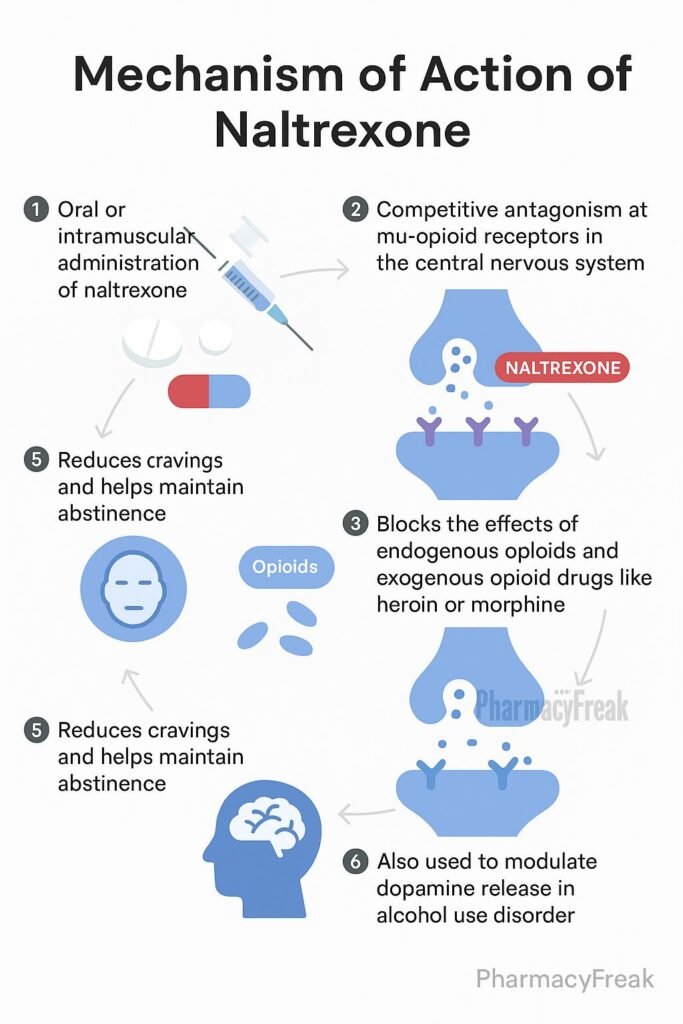Table of Contents
Introduction
Naltrexone is a pure opioid antagonist primarily used to prevent relapse in opioid use disorder and reduce alcohol craving in alcohol dependence. It competitively blocks μ-opioid receptors and to a lesser extent κ and δ receptors, thereby diminishing the rewarding effects of opioids and alcohol without inducing any agonist activity.
Step-by-Step Mechanism of Action
- Competitive μ-Opioid Receptor Antagonism
Naltrexone binds to and blocks μ-opioid receptors, preventing activation by endogenous or exogenous opioids. - Additional κ and δ Antagonism
It also competitively inhibits κ and δ receptors, contributing to its therapeutic effects. - Inhibition of Opioid-Induced Reward Pathways
By blocking opioid receptors in the mesolimbic system, it prevents dopamine release triggered by drugs or alcohol, reducing their reinforcing effects. - Reduction of Craving and Relapse
In alcohol use disorder, it attenuates pleasurable sensations from drinking and decreases urge to drink. - Precipitation of Withdrawal If Used Prematurely
Blocking receptors in opioid-dependent individuals can trigger immediate withdrawal symptoms.

Pharmacokinetic Parameters
| Parameter | Value |
|---|---|
| Bioavailability | 5–60% (due to significant first-pass metabolism) |
| Time to Peak (Tₘₐₓ) | ~1 hour (oral formulation) |
| Half-Life (Naltrexone) | ~4–5 hours |
| Half-Life (6β-Naltrexol) | ~13 hours |
| Protein Binding | ~21% |
| Volume of Distribution | High (~1350 L IV) |
| Metabolism | Hepatic → primarily 6β-naltrexol |
| Excretion | ~60–80% renal (mostly as metabolite) |
Clinical Uses
- Opioid use disorder (maintenance therapy post-detoxification)
- Alcohol use disorder (reducing relapse and heavy drinking)
- Off-label: low-dose naltrexone for chronic pain, fibromyalgia, and inflammation
Adverse Effects
- Nausea, headache
- Dizziness, fatigue
- Insomnia
- Elevated liver enzymes (requires monitoring)
- Precipitated opioid withdrawal (if active opioids present)
- Rare: hepatotoxicity at high doses
Comparative Analysis
| Feature | Naltrexone | Methadone/Suboxone |
|---|---|---|
| Receptor Action | Antagonist | Agonist or partial agonist |
| Reinforcement Reduction | Blocks rewarding effects | Provides controlled opioid effect |
| Physical Dependence | No dependence risk | Dependence risk present |
| Withdrawal Risk | Precipitates if used too soon | Reduces withdrawal symptoms |
| Monitoring Requirements | Liver function tests | Respiratory and sedation monitoring |
MCQs
1. Which receptor does naltrexone primarily block?
A. NMDA receptor
B. μ-opioid receptor
C. GABA-A receptor
D. Serotonin receptor
Answer: B
2. Naltrexone has agonist activity at opioid receptors.
A. True
B. False
Answer: B
3. Which is the active metabolite of naltrexone?
A. Naloxone
B. Morphine
C. 6β-naltrexol
D. Buprenorphine
Answer: C
4. Typical half-life of oral naltrexone is:
A. 1 hour
B. 4–5 hours
C. 12 hours
D. 24 hours
Answer: B
5. Naltrexone leads to craving reduction by:
A. Enhancing dopamine release
B. Releasing endorphins
C. Blocking reward signalling
D. Acting as a sedative
Answer: C
6. Why can naltrexone precipitate withdrawal?
A. It is a strong opioid agonist
B. It displaces opioids from receptors
C. It increases opioid metabolites
D. It blocks GABA receptors
Answer: B
7. Bioavailability of oral naltrexone is:
A. >90%
B. ~70%
C. 5–60% due to first-pass metabolism
D. 100%
Answer: C
8. Use of low-dose naltrexone is off-label for:
A. Asthma
B. Fibromyalgia and chronic pain
C. Diabetes
D. Hypertension
Answer: B
9. A major concern with naltrexone therapy is:
A. Weight loss
B. Hepatotoxicity in high doses
C. Opioid dependence
D. Cardiac arrhythmias
Answer: B
10. Which excretion route is most important?
A. Fecal
B. Pulmonary
C. Renal via metabolites
D. Sweat
Answer: C
FAQs
1. Does naltrexone produce opioid-like effects?
No. It acts purely as an opioid receptor blocker and has no agonist activity.
2. Can naltrexone be started during opioid use?
No. Initiating while opioids are present can trigger withdrawal; detox is required first.
3. Is liver monitoring necessary?
Yes. Liver enzymes should be checked before starting and periodically during treatment.
4. What is depot naltrexone?
An extended-release injectable form given monthly, useful for adherence.
5. Can naltrexone be used for pain?
Low doses may be used off-label for chronic pain and inflammation but are not FDA-approved.
References
- DrugBank – Naltrexone Drug Profile
- NCBI Bookshelf – Naltrexone Mechanism and Use
- PubMed – Pharmacokinetic Review of Naltrexone
- Clinical Review – Beta-endorphins, Alcohol, and Naltrexone
- FDA Label – Naltrexone Tablets
Related Links

I am pursuing MBA in pharmaceutical management from NIPER Hyderabad with a strong academic record and proven success in national-level pharmacy entrance exams. I secured AIR 61 in NIPER 2024 (MS/M.Pharm) and AIR 27 in NIPER MBA, along with AIR 147 in GPAT 2024 and AIR 907 in GPAT 2023. I also achieved AIR 6 in AIIMS CRE-2025 for Drug Store Keeper and was selected as a Pharmacist (AIR 61) for ESIC. Additionally, I was the Runner-Up in Round 2 of the EY Case Study Competition.
At PharmacyFreak.com, I aim to guide future pharmacists through expert content, exam strategies, and insightful resources based on real experience and academic excellence.
Mail- harsh@pharmacyfreak.com
